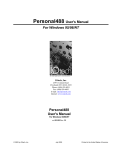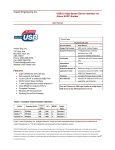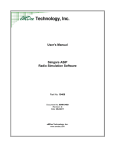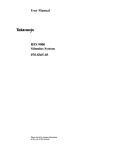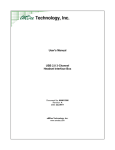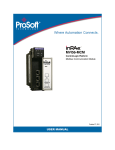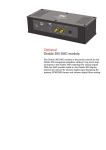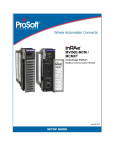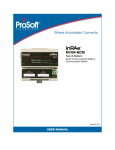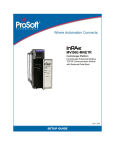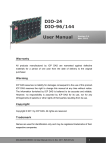Download User`s Manual USB 2.0 Audio PCA with 16 Bit I/O, 4 x 4 Audio Mixer
Transcript
User's Manual USB 2.0 Audio PCA with 16 Bit I/O, 4 x 4 Audio Mixer Part No: 10516 Document No: MAN10516 Revision: A Date: 16SEP10 eMDee Technology, Inc. www.emdee.com eMDee Technology, Inc. Document No: MAN10516 Table of Contents 1.0 Overview......................................................................................................................................................... 3 1.1 Block Diagram............................................................................................................................................ 3 1.2 Theory of Operation.................................................................................................................................... 4 1.2.1 USB Audio CODEC............................................................................................................................ 4 1.2.2 Microphone Pre-amplifiers.................................................................................................................. 4 1.2.3 Headphone/Speaker Amplifiers.......................................................................................................... 5 1.2.4 Audio Mixer......................................................................................................................................... 5 1.2.5 General-Purpose I/O (GPIO).............................................................................................................. 6 2.0 Hardware Configuration.................................................................................................................................. 7 2.1 Jumper Configurations................................................................................................................................ 7 2.1.1 Ground Connections (J1) Jumper Description....................................................................................8 2.1.2 Mic Bias Power (J7) Jumper Description............................................................................................ 8 2.1.3 Board Power (J8) Jumper Description................................................................................................ 8 2.1.4 Input Gain (J10, J13, J17, J22) Jumper Description...........................................................................9 2.1.5 Output Gain (J12, J18, J19, J20) Jumper Description........................................................................9 2.2 External Connectors................................................................................................................................. 10 2.2.1 J9, J14, J15, J16 Pinout................................................................................................................... 10 2.2.2 J5 Pinout........................................................................................................................................... 10 2.2.3 J11 Pinout......................................................................................................................................... 11 2.2.4 J21 Pinout......................................................................................................................................... 11 3.0 Software Drivers........................................................................................................................................... 12 3.1 Windows Audio Drivers............................................................................................................................. 12 3.2 Driver Installation...................................................................................................................................... 12 4.0 Software Interface......................................................................................................................................... 13 4.1 UsbI2COpen............................................................................................................................................. 13 4.2 UsbI2CClose............................................................................................................................................. 14 4.3 UsbI2CWrite............................................................................................................................................. 15 4.4 UsbI2CRead............................................................................................................................................. 18 4.5 UsbInputLevel........................................................................................................................................... 19 4.6 UsbOutputLevel........................................................................................................................................ 20 4.7 UsbOutputBalance.................................................................................................................................... 21 4.8 UsbGetInputLevel..................................................................................................................................... 22 4.9 UsbGetOutputLevel.................................................................................................................................. 23 4.10 UsbGetOutputBalance............................................................................................................................ 24 4.11 UsbGetBoardSchema............................................................................................................................. 25 5.0 Initialization Procedure.................................................................................................................................. 26 User's Manual, USB 2.0 Audio PCA with 16 Bit I/O, 4 x 4 Audio Mixer Page 2 of 26 eMDee Technology, Inc. Document No: MAN10516 1.0 OVERVIEW This document describes the characteristics, configuration, and operation of eMDee Technology part number 10516: USB 2.0 Audio PCA with 16 Bit I/O and 4 x 4 Mixer. Sections 1 and 2 of this document describe the hardware and its configuration. Sections 3, 4, and 5 describe the software drivers, API functions, and basic initialization. 1.1 Block Diagram Figure 1.1 shows a basic block diagram of the circuit board functionality. The main components of the board are the USB audio CODEC, microphone pre-amplifiers, headphone/speaker amplifiers, mixer, and general-purpose I/O (GPIO). Figure 1.1: Block Diagram User's Manual, USB 2.0 Audio PCA with 16 Bit I/O, 4 x 4 Audio Mixer Page 3 of 26 eMDee Technology, Inc. Document No: MAN10516 1.2 Theory of Operation 1.2.1 USB Audio CODEC The main component of the circuit board is the Micronas UAC3576B CODEC. This CODEC provides a USB interface, stereo audio input/ouptut, and an I 2C interface. The CODEC is compatible with the default Windows audio drivers and appears as a USB sound device when connected to a Windows PC (Windows XP with Service Pack 2 or higher is recommended). 1.2.2 Microphone Pre-amplifiers The board has the capability to connect up to four microphones as independent audio inputs. The board's preamplifiers are compatible with dynamic microphones and electret-style microphones. When using electret-style microphones, a bias voltage can be configured to power the microphone elements. Figure 1.2 shows a simplified block diagram of one of the microphone pre-amplifiers on the board. Figure 1.2: Microphone Input Block Diagram When using a dynamic microphone, you connect the two wires from the microphone to the first stage of the preamplifier. This first stage has differential inputs and has a gain of +40dB. The connection between the first and second stages of the pre-amplifier is not connected by default, so you will need to place a jumper between the two stages when using a dynamic microphone (see Section 2.2.3 for connector pinouts). When using an electret-style microphone, you connect the signal wire from the microphone to the second stage of the pre-amplifier and the ground wire to analog ground. In this case, it is not necessary to physically connect the first and second amplifier stages. If the microphone requires a bias voltage, there are several ways to connect this voltage to the microphone signal line. Refer to Section 2.1.2 for details on configuring a bias voltage. The second stage of the pre-amplifier is a variable gain amplifier that is jumper-selectable from 0dB to +36dB. Refer to Section 2.1.4 for details on setting the gain jumpers for the second amplifier stage. Also provided in the microphone pre-amplifier is a push-to-talk (PTT) detection circuit for certain types of microphones. The proper operation of this circuit will require an electret-style microphone that uses a bias voltage to power the mic element – the PTT detection circuit will not work with any other type of microphone. The PTT detection circuit monitors the voltage on the microphone signal line and generates a signal to the GPIO when the bias voltage drops below a certain level (indicating that the microphone has been activated). In order to read the PTT in this manner, you will also need to place jumpers (see Sec. 2.2.2 ) to route the signal from the PTT detection circuit to the GPIO. User's Manual, USB 2.0 Audio PCA with 16 Bit I/O, 4 x 4 Audio Mixer Page 4 of 26 eMDee Technology, Inc. Document No: MAN10516 1.2.3 Headphone/Speaker Amplifiers The board has the capability to connect up to four headphones or speakers as independent audio outputs. Each output has a power amplifier that is capable of producing up to 1.2W into an 8 ohm load. Figure 1.3 shows a simplified block diagram of one of the output amplifiers on the board. Figure 1.3: Headphone/Speaker Output Block Diagram The output of the mixer is routed to a three pin connector that can be used for external volume control of the output audio signal. Typically, a potentiometer is connected to the three pins to provide a voltage divider into the input of the amplifier to vary the output signal. If no volume control is needed, you may also insert a jumper between pins 1 and 2 of the connector to connect the full-scale signal to the amplifier. Refer to Section 2.2.1 for details on these connectors. The output amplifier is also gain adjustable from 0 to +16dB. Refer to Section 2.1.5 for details on configuration of the output amplifier gain jumpers. The output of the amplifier can be connected to a headphone or speaker. The headphone is connected between one half of the amplifier and ground while the speaker is connected to two bridged amplifiers to provide more output power. Refer to Section 2.2.4 for details on connecting headphones and/or speakers to the board. 1.2.4 Audio Mixer There is a 6 input/6 output mixer on the board that routes all of the audio to/from the inputs, outputs, and the CODEC. This is a simple mixer and contains only on/off controls for inputs to outputs and does not provide for individual volume control of the various mixer paths. It does, however, mix the audio signals together so that more than one audio signal can be combined into an output. The 6 inputs to the mixer are the 4 microphone inputs plus the left and right outputs of the CODEC. Note that the outputs of the CODEC are connected to the inputs of the mixer. This enables audio that is played from the CODEC to be sent to any of the mixer outputs. The 6 outputs from the mixer are the 4 headphone/speaker outputs plus the left and right inputs of the CODEC. Note that the outputs of the mixer are connected to the inputs of the CODEC. This enables audio from any of the microphones to be sent to the CODEC. The mixer is controlled through a software interface that enables/disables the various paths that connect inputs to outputs within the mixer. Section 4.3 details a map of the controls that are available in the mixer and how to call the API function to enable/disable the controls. User's Manual, USB 2.0 Audio PCA with 16 Bit I/O, 4 x 4 Audio Mixer Page 5 of 26 eMDee Technology, Inc. Document No: MAN10516 1.2.5 General-Purpose I/O (GPIO) A bank of discrete I/O pins are available on the board so that external devices can be connected to the board such as an external PTT switch or selection switch. There are 16 GPIO bits, of which 12 can be used for general-purpose and 4 are reserved for controlling the shutdown function for each of the output amplifiers. The GPIO pins are configurable as inputs or outputs and each bit can be configured separately as an input or an output. Refer to Section 2.2.2 for details on connecting components to the GPIO pins. Also refer to Section 4.3 for details on the software control of the GPIO. User's Manual, USB 2.0 Audio PCA with 16 Bit I/O, 4 x 4 Audio Mixer Page 6 of 26 eMDee Technology, Inc. Document No: MAN10516 2.0 HARDWARE CONFIGURATION This section describes how to configure the hardware for the various functions of the board and details the connectors that are available to external components. Figure 2.1 shows the physical layout of the circuit board identifying the jumper locations and external connector locations. Figure 2.1: Jumper and Connector Locations 2.1 Jumper Configurations Jumper Function J1 Ground Connections (see Sec. 2.1.1 ) J7 Mic Bias Power (see Sec. 2.1.2 ) J8 Board Power (see Sec. 2.1.3 ) J10 Input 1 Gain (see Sec. 2.1.4 ) J13 Input 2 Gain (see Sec. 2.1.4 ) J17 Input 3 Gain (see Sec. 2.1.4 ) J22 Input 4 Gain (see Sec. 2.1.4 ) J12 Output 1 Gain (see Sec. 2.1.5 ) J18 Output 2 Gain (see Sec. 2.1.5 ) J19 Output 3 Gain (see Sec. 2.1.5 ) J20 Output 4 Gain (see Sec. 2.1.5 ) User's Manual, USB 2.0 Audio PCA with 16 Bit I/O, 4 x 4 Audio Mixer Page 7 of 26 eMDee Technology, Inc. Document No: MAN10516 2.1.1 Ground Connections (J1) Jumper Description Jumper J1 provides the ability to connect the circuit board ground planes. The three ground planes are: • Chassis Ground – USB connector shell and mounting screws • Analog Ground – Ground reference for all audio amplifiers and mixers • Digital Ground – Ground reference for USB CODEC and digital I/O The following table shows the jumper pins with a description of each pin: Chassis Ground 1 2 Digital Ground Analog Ground 3 4 Digital Ground not used 5 6 not used 2.1.2 Mic Bias Power (J7) Jumper Description Jumper J7 (along with connector J6) provides the ability to configure the power source for the microphone bias voltage that can be used to power electret-style microphones. The following table shows the jumper pins with a description of each pin: Mic Bias 1 2 Analog +5VDC Analog Ground 3 4 n/c This jumper/connector allows for several different modes of power the mic bias: • Leave all pins of J7 unconnected (open) and connect an external 12VDC power supply to J6 (in this mode, DO NOT jumper any of the J7 pins) • Connect an external 12VDC power supply to pins 1 and 3 of J7 (in this mode, DO NOT connect anything to J6) • Place a jumper between pins 1 and 2 to connect board power (+5VDC) to the mic bias (in this mode, DO NOT connect anything to J6) • If no microphone bias voltage is needed, do not jumper or connect anything to J6 or J7. 2.1.3 Board Power (J8) Jumper Description Jumper J8 provides the ability to configure the main source of power for the circuit board. The following table shows the jumper pins with a description of each pin: USB Power (+5VDC) 1 2 Board Power Digital Ground 3 4 Board Power User's Manual, USB 2.0 Audio PCA with 16 Bit I/O, 4 x 4 Audio Mixer Page 8 of 26 eMDee Technology, Inc. Document No: MAN10516 This jumper/connector allows for two different modes of powering the circuit board: • Place a jumper between pins 1 and 2 to power the board from the USB bus power (in this mode, DO NOT connect a jumper between pins 3 & 4) • Connect an external +5VDC power supply to pins 3 and 4 (in this mode, DO NOT connect a jumper between pins 1 and 2). 2.1.4 Input Gain (J10, J13, J17, J22) Jumper Description The input gain jumpers (J10, J13, J17, J22) set the gain of the second amplifier stage (refer to Fig. 1.2.2) of the microphone inputs. The gain can be set from 0dB to +36dB in +12dB increments. The following table shows the jumper settings for the valid gain settings of the input amplifier: Jumper Location Gain 0dB +12dB +24dB +36dB 2.1.5 Output Gain (J12, J18, J19, J20) Jumper Description The output gain jumpers (J12, J18, J19, J20) set the gain of the output power amplifiers (refer to Fig. 1.3). The gain can be set from 0dB to +16dB. The following table shows the jumper settings for the valid gain settings of the output amplifier: Jumper Location Gain 0dB +11dB +16dB User's Manual, USB 2.0 Audio PCA with 16 Bit I/O, 4 x 4 Audio Mixer Page 9 of 26 eMDee Technology, Inc. Document No: MAN10516 2.2 External Connectors 2.2.1 J9, J14, J15, J16 Pinout The connectors J9, J14, J15, and J16 are provided for connection of a potentiometer to create a voltage divider between the mixer output and amplifier input so that the output signal can be varied with an external control. The potentiometer should be connected so that the wiper is connected to pin 2 and the ends of the potentiometer are connected to pins 1 and 3 so that when the potentiometer is turned completely clockwise, the resistance between pin 1 and 2 will be 0 ohms. If no external volume control is needed, you can simply insert a jumper between pins 1 and 2 to connect the full signal to the output amplifier. Mixer Output 1 Amplifier Input 2 Analog Ground 3 2.2.2 J5 Pinout GPIO Bit 0 1 2 GPIO Bit 1 GPIO Bit 2 3 4 GPIO Bit 3 Digital Ground 5 6 Digital Ground GPIO Bit 4 7 8 GPIO Bit 5 GPIO Bit 6 9 10 GPIO Bit 7 Digital Ground 11 12 Digital Ground PTT 1 Detect 13 14 GPIO Bit 8 PTT 2 Detect 15 16 GPIO Bit 9 Digital Ground 17 18 Digital Ground PTT 3 Detect 19 20 GPIO Bit 10 PTT 4 Detect 21 22 GPIO Bit 11 Digital Ground 23 24 Digital Ground User's Manual, USB 2.0 Audio PCA with 16 Bit I/O, 4 x 4 Audio Mixer Page 10 of 26 eMDee Technology, Inc. Document No: MAN10516 2.2.3 J11 Pinout Dynamic Mic 1 Input 1 2 Electret Mic 1 Input Dynamic Mic 1 Input (+) 3 4 Analog Ground Dynamic Mic 1 Input (-) 5 6 Analog Ground Dynamic Mic 2 Input 7 8 Electret Mic 2 Input Dynamic Mic 2 Input (+) 9 10 Analog Ground Dynamic Mic 2 Input (-) 11 12 Analog Ground Dynamic Mic 3 Input 13 14 Electret Mic 3 Input Dynamic Mic 3 Input (+) 15 16 Analog Ground Dynamic Mic 3 Input (-) 17 18 Analog Ground Dynamic Mic 4 Input 19 20 Electret Mic 4 Input Dynamic Mic 4 Input (+) 21 22 Analog Ground Dynamic Mic 4 Input (-) 23 24 Analog Ground Headphone 1 Output (+) 1 2 Speaker 1 Output (+) Analog Ground 3 4 Speaker 1 Output (-) Un-amplified 1 Output 5 6 Analog Ground Headphone 2 Output (+) 7 8 Speaker 2 Output (+) Analog Ground 9 10 Speaker 2 Output (-) Un-amplified 2 Output 11 12 Analog Ground Headphone 3 Output (+) 13 14 Speaker 3 Output (+) Analog Ground 15 16 Speaker 3 Output (-) Un-amplified 3 Output 17 18 Analog Ground Headphone 4 Output (+) 19 20 Speaker 4 Output (+) Analog Ground 21 22 Speaker 4 Output (-) Un-amplified 4 Output 23 24 Analog Ground 2.2.4 J21 Pinout User's Manual, USB 2.0 Audio PCA with 16 Bit I/O, 4 x 4 Audio Mixer Page 11 of 26 eMDee Technology, Inc. Document No: MAN10516 3.0 SOFTWARE DRIVERS The following sections detail the procedures for installing the Windows multimedia drivers and the specialpurpose board drivers. These procedures should be followed before attempting to use the board. 3.1 Windows Audio Drivers When the USB audio device is plugged in, Windows will automatically detect the USB CODEC and will load default sound drivers for it. 3.2 Driver Installation After the USB device has been plugged in and Windows has detected the presence of the audio device, you will need to finish the installation of the special-purpose drivers to finish your installation. The drivers are provided with your USB device. You will need to run INSTALL.EXE to start the automatic installation of the drivers. Once the drivers have been installed, you will need to unplug the USB device, wait a few seconds, and the replug the device (or you can hold the reset button down for 2 to 3 seconds). This will reboot the device with the newly installed drivers. To verify the proper installation of the special-purpose drivers, open the Device Manager in Windows and verify that a device named eMDee Composite USB-Device 0 is listed under Universal Serial Bus controllers. To verify the proper installation of the audio drivers, open the Sounds and Audio Devices Properties Control Panel window and verify that eMDee Audio 0 is available as one of the sound devices in your system. To finalize the driver installation and setup, you will need to copy the file uac2.dll into your Windows System folder. At this point the USB device is ready for communication. The following section details how to interface to the USB device through your own customized software application. User's Manual, USB 2.0 Audio PCA with 16 Bit I/O, 4 x 4 Audio Mixer Page 12 of 26 eMDee Technology, Inc. Document No: MAN10516 4.0 SOFTWARE INTERFACE The following sections detail the software interface, or API, that is available for this board. All of these functions are available in the dynamically linked library (DLL) named UsbI2C.dll. Prototypes for each function are provided in a header file named UsbI2CInterface.h. For proper operation, the USB device drivers must be loaded properly (see Section 3.1) and the files uacb.dll and uac2.dll must be in the Windows system directory. 4.1 UsbI2COpen UAC_HANDLE UsbI2cOpen(int devAddress); Return Value If successful, this function returns a handle to an open USB device that will be used as a reference in subsequent function calls. If not successful, this function returns NULL. Parameters devAddress Physical address of the USB device. The physical address of this board is always '0'. Remarks Use this function to open a USB device and retrieve a handle to it. User's Manual, USB 2.0 Audio PCA with 16 Bit I/O, 4 x 4 Audio Mixer Page 13 of 26 eMDee Technology, Inc. Document No: MAN10516 4.2 UsbI2CClose void UsbI2cClose(HANDLE devHandle); Return Value None. Parameters devHandle Handle of an open USB device (retrieved from UsbI2COpen). Remarks Use this function to close the USB device and release the driver. User's Manual, USB 2.0 Audio PCA with 16 Bit I/O, 4 x 4 Audio Mixer Page 14 of 26 eMDee Technology, Inc. Document No: MAN10516 4.3 UsbI2CWrite int UsbI2cWrite(UAC_HANDLE devHandle, unsigned short address, char *data, unsigned short length); Return Value Macro Value Description UACI2C_OK 0 Successful UACI2C_NOT_CONNECTED 1 Device not connected UACI2C_GENERAL_ERROR 2 Undefined/Generic error UACI2C_BUSY 3 Device is busy UACI2C_TIMEOUT 4 Device timed out UACI2C_NO_ACK 5 No response from device UACI2C_NO_DATA 6 No data from device Parameters devHandle Handle of an open USB device (retrieved from UsbI2COpen). address Address of the I/O bank to write to. Each I/O bank contains two 8-bit bytes. Refer to the Remarks section for details of the valid I/O banks for this board. data A pointer to two 8-bit bytes of data that will be written to the I/O bank. length The number of bytes that are allocated in the data array (for this board, the value should always be 2). Remarks Use this function to write to the general-purpose I/O (GPIO) and mixer control. The I/O arrangement for this board is 3 I/O banks, each with 16 bits. The table below shows the assignment of each bit within the I/O banks: Address Byte Bit Function 20h 0 0 GPIO Bit 0 (J5, pin 1) 1 GPIO Bit 1 (J5, pin 2) 2 GPIO Bit 2 (J5, pin 3) User's Manual, USB 2.0 Audio PCA with 16 Bit I/O, 4 x 4 Audio Mixer Page 15 of 26 eMDee Technology, Inc. Address Document No: MAN10516 Byte 1 21h 0 1 22h 0 Bit Function 3 GPIO Bit 3 (J5, pin 4) 4 GPIO Bit 4 (J5, pin 7) 5 GPIO Bit 5 (J5, pin 8) 6 GPIO Bit 6 (J5, pin 9) 7 GPIO Bit 7 (J5, pin 10) 0 GPIO Bit 8 (J5, pin 14) 1 GPIO Bit 9 (J5, pin 16) 2 GPIO Bit 10 (J5, pin 20) 3 GPIO Bit 11 (J5, pin 22) 4 Channel 1 Output Amplifier Shutdown 5 Channel 2 Output Amplifier Shutdown 6 Channel 3 Output Amplifier Shutdown 7 Channel 4 Output Amplifier Shutdown 0 Mixer Control - Input 1 to Output 1 1 Mixer Control - Input 2 to Output 1 2 Mixer Control - Input 3 to Output 1 3 Mixer Control - Input 4 to Output 1 4 Mixer Control - Input 1 to Output 2 5 Mixer Control - Input 2 to Output 2 6 Mixer Control - Input 3 to Output 2 7 Mixer Control - Input 4 to Output 2 0 Mixer Control - Input 1 to Output 3 1 Mixer Control - Input 2 to Output 3 2 Mixer Control - Input 3 to Output 3 3 Mixer Control - Input 4 to Output 3 4 Mixer Control - Input 1 to Output 4 5 Mixer Control - Input 2 to Output 4 6 Mixer Control - Input 3 to Output 4 7 Mixer Control - Input 4 to Output 4 0 Mixer Control – CODEC Left Output to Output 1 1 Mixer Control – CODEC Right Output to Output 1 2 Mixer Control – CODEC Left Output to Output 2 3 Mixer Control – CODEC Right Output to Output 2 4 Mixer Control – CODEC Left Output to Output 3 User's Manual, USB 2.0 Audio PCA with 16 Bit I/O, 4 x 4 Audio Mixer Page 16 of 26 eMDee Technology, Inc. Address Document No: MAN10516 Byte 1 Bit Function 5 Mixer Control – CODEC Right Output to Output 3 6 Mixer Control – CODEC Left Output to Output 4 7 Mixer Control – CODEC Right Output to Output 4 0 Mixer Control – Input 1 to CODEC Left Input 1 Mixer Control – Input 2 to CODEC Left Input 2 Mixer Control – Input 3 to CODEC Left Input 3 Mixer Control – Input 4 to CODEC Left Input 4 Mixer Control – Input 1 to CODEC Right Input 5 Mixer Control – Input 2 to CODEC Right Input 6 Mixer Control – Input 3 to CODEC Right Input 7 Mixer Control – Input 4 to CODEC Right Input User's Manual, USB 2.0 Audio PCA with 16 Bit I/O, 4 x 4 Audio Mixer Page 17 of 26 eMDee Technology, Inc. Document No: MAN10516 4.4 UsbI2CRead int UsbI2cRead(UAC_HANDLE devHandle, unsigned short address, char *data, unsigned short length); Return Value Macro Value Description UACI2C_OK 0 Successful UACI2C_NOT_CONNECTED 1 Device not connected UACI2C_GENERAL_ERROR 2 Undefined/Generic error UACI2C_BUSY 3 Device is busy UACI2C_TIMEOUT 4 Device timed out UACI2C_NO_ACK 5 No response from device UACI2C_NO_DATA 6 No data from device Parameters devHandle Handle of an open USB device (retrieved from UsbI2COpen). address Address of the I/O bank to write to. Each I/O bank contains two 8-bit bytes. Refer to the Remarks section for details of the valid I/O banks for this board. data A pointer to two 8-bit bytes of data that will receive the data from the I/O bank. length The number of bytes that are allocated in the data array (for this board, the value should always be 2). Remarks Use this function to read from the general-purpose I/O (GPIO). On this board, there are 12 bits of GPIO. Each of these bits can be configured as either input (read) or output (write). To configure a bit as an input, you must first write a '1' to that bit to enable it as an input bit. These bits will be latched in, there is no need to re-write the bits before each read. For example, to configure GPIO bits 0, 3, 6, and 9 as inputs, use UsbI2CWrite to send 49h (0100 1001b) and 02h (0000 0010b) to the I/O bank at address 20h. Then perform a UsbI2CRead to read from the same I/O bank to get the value of the bits configured as input. Since the inputs are active low, an input that is connected to ground will read back as a '0' on that bit. Note that bits 4 – 7 of byte 1 are reserved for shutdown control of the amplifiers. These bits must always be written as '0' when configuring the GPIO. A '1' written to these bits will put the amplifier in “shutdown” mode. User's Manual, USB 2.0 Audio PCA with 16 Bit I/O, 4 x 4 Audio Mixer Page 18 of 26 eMDee Technology, Inc. Document No: MAN10516 4.5 UsbInputLevel int UsbInputLevel(UAC_HANDLE devHandle, float level, int leftOrRight); Return Value Macro Value Description UACI2C_OK 0 Successful UACI2C_NOT_CONNECTED 1 Device not connected UACI2C_GENERAL_ERROR 2 Undefined/Generic error UACI2C_BUSY 3 Device is busy UACI2C_TIMEOUT 4 Device timed out UACI2C_NO_ACK 5 No response from device UACI2C_NO_DATA 6 No data from device Parameters devHandle Handle of an open USB device (retrieved from UsbI2COpen). level A normalized value from 0.0 to 1.0 that represents the volume level of the input. A value of 0.0 will be minimum volume and a value of 1.0 will be maximum volume. leftOrRight Writes level to the left or right channel based on the following values: 0 = Left CODEC channel 1 = Right CODEC channel Remarks Use this function to set the input volume level of the audio CODEC. This function can be used to control the overall level of the audio signals that will be captured by the CODEC. User's Manual, USB 2.0 Audio PCA with 16 Bit I/O, 4 x 4 Audio Mixer Page 19 of 26 eMDee Technology, Inc. Document No: MAN10516 4.6 UsbOutputLevel int UsbOutputLevel(UAC_HANDLE devHandle, float level); Return Value Macro Value Description UACI2C_OK 0 Successful UACI2C_NOT_CONNECTED 1 Device not connected UACI2C_GENERAL_ERROR 2 Undefined/Generic error UACI2C_BUSY 3 Device is busy UACI2C_TIMEOUT 4 Device timed out UACI2C_NO_ACK 5 No response from device UACI2C_NO_DATA 6 No data from device Parameters devHandle Handle of an open USB device (retrieved from UsbI2COpen). level A normalized value from 0.0 to 1.0 that represents the volume level of the output. A value of 0.0 will be minimum volume and a value of 1.0 will be maximum volume. Remarks Use this function to set the output volume level of the audio CODEC. This is the overall volume level of both channels of the CODEC. This function, in combination with UsbOutputBalance can be used to set the level of the left and right output channels of the CODEC. User's Manual, USB 2.0 Audio PCA with 16 Bit I/O, 4 x 4 Audio Mixer Page 20 of 26 eMDee Technology, Inc. Document No: MAN10516 4.7 UsbOutputBalance int UsbOutputBalance(UAC_HANDLE devHandle, float fPan); Return Value Macro Value Description UACI2C_OK 0 Successful UACI2C_NOT_CONNECTED 1 Device not connected UACI2C_GENERAL_ERROR 2 Undefined/Generic error UACI2C_BUSY 3 Device is busy UACI2C_TIMEOUT 4 Device timed out UACI2C_NO_ACK 5 No response from device UACI2C_NO_DATA 6 No data from device Parameters devHandle Handle of an open USB device (retrieved from UsbI2COpen). fPan A normalized value from -1.0 to 1.0 representing the balance, or pan, of the output. A value of -1.0 will pan the output completely to the left channel and a value of 1.0 will pan the output completely to the right channel. The value is continuous between -1.0 and 1.0 with a value of 0.0 being the center (equal volume to both left and right channels). Remarks Use this function to set the output balance of the audio CODEC. This is the “pan position” for the audio signals being sent from the audio CODEC. This function, in combination with UsbOutputLevel can be used to set the level of the left and right output channels of the CODEC. User's Manual, USB 2.0 Audio PCA with 16 Bit I/O, 4 x 4 Audio Mixer Page 21 of 26 eMDee Technology, Inc. Document No: MAN10516 4.8 UsbGetInputLevel float UsbGetInputLevel(UAC_HANDLE devHandle, int leftOrRight); Return Value The input level that is currently set for the audio CODEC. Parameters devHandle Handle of an open USB device (retrieved from UsbI2COpen). leftOrRight Reads the input level from the left or right channel based on the following values: 0 = Left CODEC channel 1 = Right CODEC channel Remarks Use this function to retrieve the input volume level of the audio CODEC. This function can be used to read the default levels of the CODEC after initialization, or to verify the value written from a call to UsbInputLevel. User's Manual, USB 2.0 Audio PCA with 16 Bit I/O, 4 x 4 Audio Mixer Page 22 of 26 eMDee Technology, Inc. Document No: MAN10516 4.9 UsbGetOutputLevel float UsbGetOutputLevel(UAC_HANDLE devHandle); Return Value The output level that is currently set for the audio CODEC. Parameters devHandle Handle of an open USB device (retrieved from UsbI2COpen). Remarks Use this function to retrieve the output volume level of the audio CODEC. This function can be used to read the default level of the CODEC after initialization, or to verify the value written from a call to UsbOutputLevel. User's Manual, USB 2.0 Audio PCA with 16 Bit I/O, 4 x 4 Audio Mixer Page 23 of 26 eMDee Technology, Inc. Document No: MAN10516 4.10 UsbGetOutputBalance float UsbGetOutputBalance(UAC_HANDLE devHandle); Return Value The output balance that is currently set for the audio CODEC. Parameters devHandle Handle of an open USB device (retrieved from UsbI2COpen). Remarks Use this function to retrieve the output balance of the audio CODEC. This function can be used to read the default value of the CODEC after initialization, or to verify the value written from a call to UsbOutputBalance. User's Manual, USB 2.0 Audio PCA with 16 Bit I/O, 4 x 4 Audio Mixer Page 24 of 26 eMDee Technology, Inc. Document No: MAN10516 4.11 UsbGetBoardSchema int UsbGetBoardSchema(UAC_HANDLE devHandle); Return Value The value of the board schema (see Remarks). Parameters devHandle Handle of an open USB device (retrieved from UsbI2COpen). Remarks Use this function to retrieve the schema value of the circuit board hardware. This value is hard-wired as '1' and represents the current (and only) revision level of the hardware. This function is provided so that the same software can be used for different versions of hardware. User's Manual, USB 2.0 Audio PCA with 16 Bit I/O, 4 x 4 Audio Mixer Page 25 of 26 eMDee Technology, Inc. Document No: MAN10516 5.0 INITIALIZATION PROCEDURE To initialize the board and get it ready for use: 1. Call UsbI2COpen and save the returned value as the handle to the open device 2. (optional) Call UsbGetInputLevel to retrieve the CODEC left and right channel input volume settings 3. (optional) Call UsbGetOutputLevel and UsbGetOutputBalance to retrieve the CODEC output volume and pan settings 4. Call UsbI2CWrite to address 0x20 with bytes FFh and 0Fh. This will enable the four output amplifiers and configure GPIO bits 0 through 12 as inputs (refer to the UsbI2CRead documentation in section 4.4 for details on configuring the GPIO bits as outputs). The board is now ready for general use. You can record from and playback to the CODEC device just as you would any standard Windows audio device. Refer to the UsbI2CWrite documentation in section 4.3 for details on how to route and mix the CODEC audio to the outputs and the audio inputs to the CODEC. Before exiting your application, call UsbClose with the handle to the open device to release the driver. User's Manual, USB 2.0 Audio PCA with 16 Bit I/O, 4 x 4 Audio Mixer Page 26 of 26



























